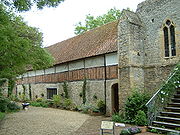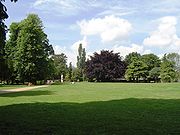
Abingdon Abbey
Encyclopedia


Abingdon, Oxfordshire
Abingdon or archaically Abingdon-on-Thames is a market town and civil parish in Oxfordshire, England. It is the seat of the Vale of White Horse district. Previously the county town of Berkshire, Abingdon is one of several places that claim to be Britain's oldest continuously occupied town, with...
, historically
Historic counties of England
The historic counties of England are subdivisions of England established for administration by the Normans and in most cases based on earlier Anglo-Saxon kingdoms and shires...
in the county of Berkshire
Berkshire
Berkshire is a historic county in the South of England. It is also often referred to as the Royal County of Berkshire because of the presence of the royal residence of Windsor Castle in the county; this usage, which dates to the 19th century at least, was recognised by the Queen in 1957, and...
but now in Oxfordshire
Oxfordshire
Oxfordshire is a county in the South East region of England, bordering on Warwickshire and Northamptonshire , Buckinghamshire , Berkshire , Wiltshire and Gloucestershire ....
, England
England
England is a country that is part of the United Kingdom. It shares land borders with Scotland to the north and Wales to the west; the Irish Sea is to the north west, the Celtic Sea to the south west, with the North Sea to the east and the English Channel to the south separating it from continental...
.
History
The abbey was supposedly founded in 675 either by CissaCissa (West Saxon)
Cissa was supposedly the viceroy of king Centwine of Wessex . Cissa is sometimes said to have himself been a king of Wessex, but does not feature in the king lists or genealogies. He is said to have constructed Chisbury Camp, and to have founded Abingdon Abbey.-References:*Kelly, S. E. 2000....
, viceroy of Centwine
Centwine of Wessex
Centwine was King of Wessex from circa 676 to 685 or 686, although he was perhaps not the only king of the West Saxons at the time.The Anglo-Saxon Chronicle reports that Centwine became king circa 676, succeeding Æscwine...
, king of the West Saxons, or by his nephew Hean, in honour of the Virgin Mary, for twelve Benedictine
Benedictine
Benedictine refers to the spirituality and consecrated life in accordance with the Rule of St Benedict, written by Benedict of Nursia in the sixth century for the cenobitic communities he founded in central Italy. The most notable of these is Monte Cassino, the first monastery founded by Benedict...
monks.
Endowed by successive West Saxon kings, it grew in importance and wealth until its destruction by the Danes
Viking
The term Viking is customarily used to refer to the Norse explorers, warriors, merchants, and pirates who raided, traded, explored and settled in wide areas of Europe, Asia and the North Atlantic islands from the late 8th to the mid-11th century.These Norsemen used their famed longships to...
in the reign of King Alfred, and the sequestration of its estates by Alfred because the monks had not made him a sufficient requital for vanquishing their enemies. There is a collection of 136 charters granted to this abbey by various Saxon kings, and the Chronicle of the Monastery of Abingdon
Historia Ecclesie Abbendonensis
The Historia Ecclesie Abbendonensis or History of the Church of Abingdon was a medieval chronicle written at Abingdon Abbey in England in the 12th century.-Background:The Historia is one of a number of monastic histories...
was written at the Abbey in the 12th century.
Amongst its abbots were Saint Aethelwold
Æthelwold of Winchester
Æthelwold of Winchester , was Bishop of Winchester from 963 to 984 and one of the leaders of the tenth century monastic reform movement in Anglo-Saxon England....
, afterwards Bishop of Winchester
Bishop of Winchester
The Bishop of Winchester is the head of the Church of England diocese of Winchester, with his cathedra at Winchester Cathedral in Hampshire.The bishop is one of five Church of England bishops to be among the Lords Spiritual regardless of their length of service. His diocese is one of the oldest and...
(954), and Richard of Hendred, for whose appointment the King's consent was obtained in 1262. He was present at the Council of Lyon
Council of Lyon
The Council of Lyon refers to either the 13th or 14th ecumenical councils of the Roman Catholic Church, both held in Lyon, France during the 13th century:*First Council of Lyon...
in 1272.
The last Abbot of Abingdon was Thomas Pentecost alias Rowland, who was among the first to acknowledge the Royal Supremacy
Acts of Supremacy
The first Act of Supremacy was a piece of legislation that granted King Henry VIII of England Royal Supremacy, which means that he was declared the supreme head of the Church of England. It is still the legal authority of the Sovereign of the United Kingdom...
. With the rest of his community he signed the surrender of his monastery in 1538, receiving the manor of Cumnor
Cumnor
Cumnor is a village and civil parish west of the centre of Oxford, England. The parish of Cumnor includes Cumnor Hill, , Chawley , the Dean Court area on the edge of Botley and the outlying settlements of Chilswell, Farmoor and Swinford...
for life or until he had preferment to the extent of £223 per annum. The revenues of the Abbey (26 Hen. VIII) were valued at £1876, 10s, 9d.
Ælfric of Abingdon was originally buried here, before being translated to Canterbury Cathedral
Canterbury Cathedral
Canterbury Cathedral in Canterbury, Kent, is one of the oldest and most famous Christian structures in England and forms part of a World Heritage Site....
. Sideman (bishop)
Sideman (bishop)
Sideman was a medieval Bishop of Crediton.He was elected to Crediton in 973. He died on 30 April or 1 May or 2 May in 977. According to Byrhtferth of Ramsey, Sideman was a protege of Ælfhere, ealdorman of Mercia. The same source says that Edward the Martyr was fostered by Sideman for a time before...
was buried here, too.
Extant buildings

Folly
In architecture, a folly is a building constructed primarily for decoration, but either suggesting by its appearance some other purpose, or merely so extravagant that it transcends the normal range of garden ornaments or other class of building to which it belongs...
built in the 1920s. Some of its architectural features are dubiously said to have come from the old abbey.
Associated monastic buildings do, however, survive, including the Abbey Exchequer, the timber-framed Long Gallery, the Abbey bakehouse, (all in the care of the Friends of Abingdon Civic Society) the Abbey gateway, St John's hospitium (pilgrims'
Pilgrim
A pilgrim is a traveler who is on a journey to a holy place. Typically, this is a physical journeying to some place of special significance to the adherent of a particular religious belief system...
hostel) and the Church of Saint Nicolas
St Nicolas' Church, Abingdon
The Church of Saint Nicolas is an Church of England parish church in Abingdon in the English county of Oxfordshire .-History:...
.
One of the original fire places was removed and is now still intact in and was moved to Lacies Court.
See also
- Abbots of Abingdon
- Cosener's HouseCosener's HouseThe Cosener's House is on an island in the River Thames within the original grounds of Abingdon Abbey, located near the centre of the town of Abingdon, Oxfordshire, England. It is run as a conference centre with accommodation by the Science and Technology Facilities Council...
, a conference centre in the grounds of the Abbey

